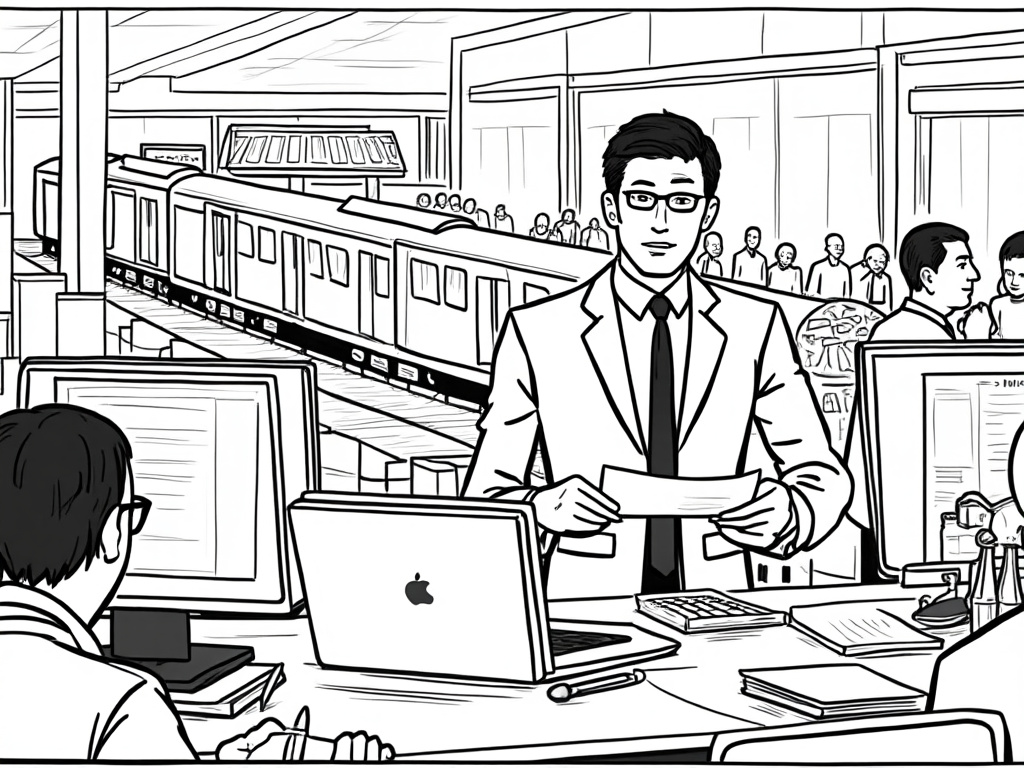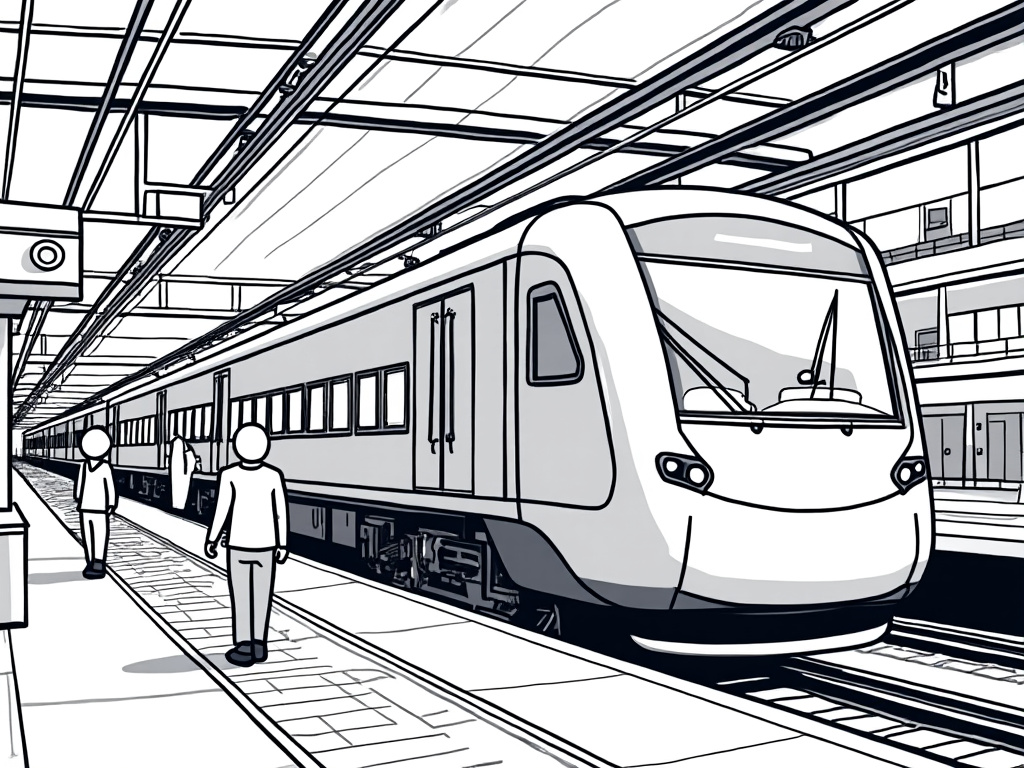
UAE National Railway Network: Transforming the Middle East’s Transportation Landscape
Reading time: 12 minutes
Table of Contents
- Introduction: The Railway Revolution in the Desert
- Historical Development and Strategic Vision
- Etihad Rail: The Cornerstone Project
- Economic and Social Transformation
- Engineering Marvels: Overcoming Desert Challenges
- Sustainability and Environmental Considerations
- Regional Connectivity: The GCC Railway Network
- Future Expansion and Passenger Services
- Navigating Forward: The UAE’s Railway Renaissance
- Frequently Asked Questions
Introduction: The Railway Revolution in the Desert
The United Arab Emirates is rewriting its transportation narrative through one of the most ambitious infrastructure projects in the Middle East: the UAE National Railway Network. In a region traditionally dominated by road transport and aviation, this extensive rail system represents not merely a transportation alternative but a fundamental economic and strategic repositioning.
Imagine traversing the rolling dunes of Abu Dhabi to the mountainous regions of Fujairah in a fraction of the time it takes by road. Picture freight moving seamlessly from Jebel Ali Port to industrial zones without congesting highways. This isn’t just infrastructure development—it’s a reimagining of connectivity in a nation that has consistently turned visionary ideas into reality.
The UAE’s railway ambitions extend beyond domestic considerations. As a pivotal component of the broader Gulf Cooperation Council (GCC) Railway Network, this system promises to redraw logistics maps across the Arabian Peninsula, positioning the UAE as the region’s transportation hub.
Let’s explore the transformative journey of the UAE’s railway development and understand why it represents one of the most significant strategic investments in the nation’s future.
Historical Development and Strategic Vision
The UAE’s railway aspirations weren’t born overnight. They emerged from a careful strategic analysis of the nation’s long-term economic and developmental needs.
From Vision to Blueprint
The initial conceptualization of a national railway network began in the early 2000s, as UAE leadership recognized the limitations of an economy overly dependent on road transportation and aviation. The formal planning phase accelerated in 2009 with the establishment of Etihad Rail (originally Union Railway), tasked with developing and operating the national freight and passenger railway network.
What made this vision particularly bold was its timing—coming during global economic uncertainty following the 2008 financial crisis. While many countries were scaling back infrastructure ambitions, the UAE doubled down on its commitment to transformative projects.
“The UAE National Railway represents our belief that infrastructure isn’t merely about connecting places—it’s about connecting possibilities,” noted HH Sheikh Mohammed bin Rashid Al Maktoum during the project’s early phases.
Strategic Imperatives
The railway strategy aligned with several core national objectives:
- Economic Diversification: Reducing dependency on oil by strengthening logistics, manufacturing, and trade sectors
- Sustainability Goals: Decreasing carbon emissions through efficient freight and passenger transport
- Regional Integration: Enhancing connectivity with neighboring GCC states
- Urban-Rural Balance: Connecting industrial zones with ports and urban centers
This wasn’t merely transportation planning—it was nation building through infrastructure. The initial masterplan envisioned a 1,200 km network connecting all seven emirates and integrating with the planned GCC railway network, effectively positioning the UAE as the crossroads of regional trade.
Etihad Rail: The Cornerstone Project
Etihad Rail stands as the institutional embodiment of the UAE’s railway ambitions, tasked with both construction and operation of the national network.
Phased Development Approach
The implementation strategy adopted a pragmatic, phased approach:
Phase 1 (Completed 2016): The initial 264 km route connected the gas fields at Shah and Habshan to the port and industrial city of Ruwais. This segment demonstrated immediate commercial viability by transporting granulated sulfur from gas processing facilities to export terminals, replacing approximately 10,000 truck trips monthly.
Phase 2 (Ongoing): This extensive 605 km segment connects Ghuweifat on the Saudi border to Fujairah on the east coast, passing through key industrial areas, ports, and population centers. The route includes critical connections to Khalifa Port, Jebel Ali Port, and industrial zones in Abu Dhabi and Dubai.
Phase 3 (Planned): The final phase will extend the network to the northern emirates and connect to the Oman border, completing the vision of nationwide connectivity.
By February 2023, over 70% of the Phase 2 network had been completed, with major milestones including the connection of Abu Dhabi and Dubai by rail for the first time in history.
Technical Specifications and Operations
The Etihad Rail network isn’t just ambitious in scope—it’s technically sophisticated:
- Standard gauge (1,435 mm) tracks compatible with GCC railway specifications
- Designed for mixed traffic with freight trains operating at 120 km/h and passenger trains at up to 200 km/h
- State-of-the-art signaling systems utilizing ETCS Level 2 technology
- Major bridges, tunnels, and underpasses to navigate challenging terrain
- Advanced maintenance facilities and operation control centers
The operational model includes both direct operations by Etihad Rail and partnerships with specialized operators. In a notable example, Etihad Rail has partnered with SNCF International (the French national railway’s international arm) to develop passenger services, leveraging their expertise in high-speed operations.
Economic and Social Transformation
The UAE National Railway Network represents far more than tracks and trains—it’s a catalyst for economic restructuring and social development.
Economic Multiplier Effects
The railway project generates economic benefits through multiple channels:
Direct Economic Impacts: The construction phase alone has created over 9,000 jobs and contracted more than 500 local companies. Upon full operation, the network is expected to employ approximately 3,000 skilled workers.
Logistics Efficiency: The most immediate benefit comes from freight cost reduction. According to Etihad Rail’s analysis, rail transport costs approximately 30% less than truck transport for bulk commodities over comparable distances.
Consider the case of Al Rawabi, one of the UAE’s largest dairy producers. By shifting their distribution from trucks to rail, they’ve projected annual savings of AED 8-10 million and reduced their carbon footprint by approximately 20%.
Industrial Development: The railway has sparked new industrial zones along key corridors. The Kizad logistics zone in Abu Dhabi has attracted over AED 1.5 billion in new investments specifically citing rail connectivity as a decisive factor.
| Economic Indicator | Pre-Railway Baseline | Projected Impact by 2030 | Long-term Vision (2040) |
|---|---|---|---|
| Logistics Costs (% of GDP) | 13.5% | 11.7% | 9.8% |
| Annual CO₂ Reduction (tons) | 0 | 2.2 million | 4.8 million |
| Job Creation (cumulative) | 0 | 15,000 | 25,000+ |
| Economic Value Added (AED) | 0 | 70 billion | 200 billion |
| Road Congestion Reduction (%) | 0% | 20% | 35% |
Social and Regional Development
Beyond economics, the railway network addresses critical social development challenges:
Regional Equity: Historically, the northern emirates have lagged behind Abu Dhabi and Dubai in economic development. The railway connects these regions to major economic centers, facilitating more balanced growth.
Urban Mobility: The planned passenger services will connect major population centers, providing alternatives to congested highways. Estimates suggest the Abu Dhabi-Dubai passenger line could remove up to 250,000 car trips annually.
Knowledge Transfer: The project has become a catalyst for technical education, with Etihad Rail partnering with higher education institutions to develop specialized programs in railway engineering and operations.
As Abdullah Al Kathiri, Director General of the Federal Transport Authority, noted: “The national railway isn’t merely about moving goods efficiently—it’s about moving the entire country forward by connecting communities and creating opportunities beyond the major urban centers.”
Engineering Marvels: Overcoming Desert Challenges
Building a railroad through one of the world’s most challenging environments has required innovative engineering solutions and adaptive planning.
Desert Engineering
The UAE’s harsh desert environment presents unique challenges for railway construction:
Shifting Sand Dunes: Among the most formidable obstacles are the constantly moving sand dunes. Engineers developed specialized “sand mitigation systems” including aerodynamic barriers and strategic vegetation to prevent sand accumulation on tracks.
Extreme Temperatures: With summer temperatures exceeding 50°C (122°F), thermal expansion of rails posed significant safety risks. The solution involved specialized “thermal stress-free” track installation techniques and continuous welded rail with expansion joints at strategic intervals.
Flash Floods: Despite being predominantly desert, the UAE experiences occasional intense rainfall, particularly in mountainous regions. The railway design incorporates over 300 culverts and bridges specifically designed to channel flash flood waters safely away from the track infrastructure.
Mountain Crossings: The route through the Hajar Mountains between Fujairah and the interior required extensive tunneling. The Al Bithnah tunnel, at 1.8 km, represents one of the engineering highlights of the project, cutting through solid rock while maintaining precise gradient specifications.
Dr. Abdulrahman Al Awar, former Director of Technical Affairs at Etihad Rail, explained: “Every kilometer of this railway tells a story of engineering innovation. We’ve essentially written new chapters in the textbook of desert railway construction.”
Technology Integration
Beyond physical engineering, the project incorporates cutting-edge technologies:
- Predictive Maintenance: IoT sensors monitor track conditions, allowing for maintenance based on actual conditions rather than fixed schedules
- Autonomous Inspection: Drone systems regularly survey remote sections of track to identify potential issues
- Advanced Signaling: The European Train Control System (ETCS) Level 2 provides continuous digital communication between trains and control centers
- Renewable Power: Solar power systems supply energy to signaling and communication equipment in remote locations
The Etihad Rail Operations Control Center in Faya represents one of the most technologically advanced railway management facilities in the region, with capabilities to monitor and control operations across the entire network from a single location.
Sustainability and Environmental Considerations
In a region known for its ecological challenges, the railway project has placed sustainability at its core.
Environmental Benefits
The shift from road to rail transport generates significant environmental advantages:
Carbon Emissions Reduction: A fully operational network is projected to reduce carbon emissions by 2.2 million tons annually by 2030, equivalent to removing approximately 375,000 cars from UAE roads.
Fuel Efficiency: Rail transport is approximately 5-8 times more fuel-efficient than trucks for freight movement. For every ton-kilometer of freight shifted from road to rail, approximately 70-80% less energy is consumed.
Wildlife Protection: The railway design incorporates 95 animal crossing points, including dedicated wildlife bridges in environmentally sensitive areas. These crossings were designed based on extensive environmental impact studies to minimize disruption to natural migration patterns.
Environmental Impact Comparison: Rail vs. Road Transport
Rail (30%)
Road (100%)
Rail (25%)
Road (100%)
Rail (15%)
Road (100%)
Sustainable Construction Practices
The project has implemented numerous sustainability initiatives during the construction phase:
Water Conservation: Advanced dust suppression systems reduce water usage by up to 70% compared to traditional methods. Additionally, treated wastewater is used for non-critical construction activities.
Material Reuse: Over 90% of excavated material has been repurposed within the project, significantly reducing waste. In rocky areas, crushed excavation material is processed and used as ballast and sub-ballast.
Renewable Energy: Solar panels power remote signaling equipment and monitoring stations, reducing the need for diesel generators and creating an autonomous, low-maintenance system.
The sustainability initiatives have garnered international recognition, with the project receiving the Green Line Award from the International Union of Railways (UIC) in 2022 for its innovative environmental protection measures.
Regional Connectivity: The GCC Railway Network
The UAE National Railway Network represents a crucial component in an even more ambitious vision: the Gulf Cooperation Council (GCC) Railway Network.
The GCC Railway Vision
The GCC Railway aims to connect all six Gulf states (Saudi Arabia, UAE, Qatar, Bahrain, Kuwait, and Oman) through approximately 2,177 km of track. This would create an unprecedented transportation corridor from Kuwait City to Muscat, revolutionizing regional logistics.
The UAE’s western section connecting to the Saudi border at Ghuweifat is specifically designed as the linkage point to this broader network, with compatible technical specifications and operational protocols.
While the overall GCC project has faced delays, the UAE has consistently maintained its commitment to completing its portion. As HE Suhail Al Mazrouei, UAE Minister of Energy and Infrastructure, stated: “We view our national railway not as an isolated system, but as part of an integrated GCC network that will reshape how people and goods move throughout the Arabian Peninsula.”
Strategic Implications
The regional connectivity brings several strategic advantages:
Trade Facilitation: A connected railway network could increase intra-GCC trade by an estimated 20%. Currently, approximately 5% of GCC internal trade moves by sea, despite the countries sharing land borders, due to logistics inefficiencies.
Port Synergies: The railway creates new possibilities for cooperation between major ports. For example, cargo arriving at Jebel Ali could be efficiently transported to Saudi Arabia’s industrial zones without transshipment.
A practical illustration of this potential comes from ADNOC’s experience with Phase 1 operations. The company reduced logistics costs by approximately 30% when transporting sulfur to Ruwais port via rail compared to truck transport. When extended across the GCC, similar efficiencies could transform regional economics.
Tourism Development: Passenger services on the GCC network would enable new tourism corridors, allowing visitors to experience multiple countries within a single trip without air travel.
The railway also represents a political statement about regional cooperation, providing physical infrastructure that embodies the GCC’s aspirations for greater economic integration.
Future Expansion and Passenger Services
While the initial focus has been on freight transport, passenger services represent the next frontier in the UAE’s railway development.
Passenger Service Development
Etihad Rail has announced ambitious plans for passenger services connecting 11 cities and regions across the UAE, from Al Sila in the west to Fujairah in the east. Key aspects include:
High-Speed Connections: The Abu Dhabi-Dubai section will feature trains operating at speeds up to 200 km/h, reducing travel time between the two cities to approximately 50 minutes—less than half the time of the current road journey.
Integrated Transport: Railway stations will connect with local public transportation, including Dubai Metro and Abu Dhabi’s developing transit system. The Al Maktoum International Airport station will provide direct rail access to what will eventually be one of the world’s largest airports.
Passenger Experience: Trains will feature multiple classes of service with amenities including Wi-Fi, entertainment systems, and dedicated business facilities. The design emphasizes both comfort and cultural elements that reflect UAE heritage.
Hassan Al Mansouri, a transportation analyst with Capital Economics, observes: “The passenger services will fundamentally alter how people conceive of distance within the UAE. When you can travel from Abu Dhabi to Fujairah in 100 minutes with no traffic concerns, the psychological geography of the country changes.”
Urban Transit Integration
Beyond intercity connections, plans include integration with urban transit systems:
- Dubai Connection: The railway will connect with multiple Dubai Metro stations, creating seamless transfers between regional and urban rail
- Abu Dhabi Metro: The developing Abu Dhabi Metro system has been designed with interchange stations connecting to the national railway
- Northern Emirates: Light rail systems planned for Sharjah and other northern emirates will include connection points to the national network
The passenger element introduces new complexities, from station design to scheduling and fare integration. To address these challenges, Etihad Rail has partnered with SNCF International, leveraging their experience with the TGV high-speed system in France.
Initial passenger services are scheduled to begin operations between Abu Dhabi and Dubai by 2025, with the full passenger network operational by 2030. When complete, the system is projected to carry more than 36.5 million passengers annually.
Navigating Forward: The UAE’s Railway Renaissance
The UAE National Railway Network represents more than infrastructure—it embodies a strategic pivot toward sustainable, integrated transportation that will reshape the nation’s economic geography. As we look toward full implementation, several key considerations will determine the ultimate impact of this transformative project:
Strategic Implementation Roadmap
- Complete the Core Network (2023-2025) – Finalize the remaining sections of Phase 2, establishing the east-west and north-south corridors that form the backbone of the system
- Introduce Initial Passenger Services (2025-2027) – Launch passenger operations on high-demand routes, particularly the Abu Dhabi-Dubai corridor
- Develop Multimodal Logistics Centers (2025-2028) – Establish strategic logistics hubs at key railway intersections to maximize freight efficiency
- Integrate with GCC Network (2027-2030) – Complete connections to neighboring countries as the broader GCC railway develops
- Expand Urban Connectivity (2028-2032) – Develop branch lines and urban connections to maximize the network’s reach and utility
The true measure of success will not be merely kilometers of track laid or tons of freight moved, but how the railway transforms broader economic and social patterns. Will industrial development truly shift to railway corridors? Will passenger services meaningfully reduce road congestion? These questions will determine whether the railway becomes simply infrastructure or a genuine economic catalyst.
For businesses, especially those in logistics, manufacturing, and trade sectors, now is the time to incorporate the railway into strategic planning. Companies that position their operations to leverage rail connectivity will gain significant cost and sustainability advantages in the coming decade.
As Sheikh Zayed bin Sultan Al Nahyan once observed, “A nation without a past is a nation without a present or future.” The UAE’s railway project connects not just places but timeframes—linking the nation’s trading heritage with its innovative present and sustainable future. How will you position yourself to be part of this railway renaissance?
Frequently Asked Questions
When will passenger services begin operating on the UAE National Railway?
Initial passenger services between Abu Dhabi and Dubai are scheduled to begin operations in 2025, with trains operating at speeds up to 200 km/h. This will reduce travel time between the two cities to approximately 50 minutes. The complete passenger network connecting 11 cities and regions across the UAE is expected to be fully operational by 2030. The system is designed to eventually carry more than 36.5 million passengers annually.
How does the UAE National Railway Network address environmental concerns?
The railway incorporates extensive environmental considerations, including a projected reduction of 2.2 million tons of CO₂ emissions annually by 2030 through shifting freight from road to rail. The project includes 95 wildlife crossing points to maintain natural migration patterns and uses advanced dust suppression systems that reduce water usage by up to 70%. Additionally, solar power supplies energy to signaling and communication equipment in remote locations, while over 90% of excavated materials have been repurposed within the project to minimize waste.
What economic benefits is the UAE National Railway expected to deliver?
The railway project is projected to generate AED 200 billion in economic value added over the long term while reducing logistics costs from 13.5% of GDP to 9.8% by 2040. Direct benefits include approximately 30% lower transportation costs compared to trucks for bulk commodities. The construction phase has created over 9,000 jobs and contracted more than 500 local companies, while the operational network is expected to employ approximately 3,000 skilled workers. The project has also catalyzed new industrial development, with zones like Kizad in Abu Dhabi attracting over AED 1.5 billion in investments specifically citing rail connectivity as a decisive factor.


